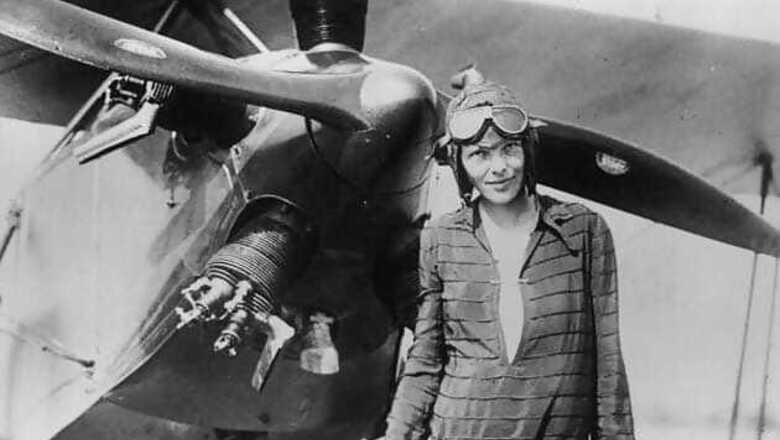
views
New Delhi: With the view to celebrate the 115th birth anniversary of the first aviatrix to fly solo across the Atlantic Ocean - Amelia Mary Earhart, Google has today replaced its usual logo with a doodle that features Earhart climbing up the aircraft "Lockheed 5B Vega," which she used to fly alone across the Atlantic Ocean in 1932.
But, besides the fact that Amelia Mary Earhart was the first woman to fly solo across the Atlantic Ocean, there are many other interesting facts about her that you all should know.
Earhart was not only an aviatrix, but she was also a famous author. She was a successful and heavily promoted writer who served as aviation editor for Cosmopolitan magazine from 1928 to 1930. In addition, she wrote magazine articles, newspaper columns, and also published books based on her experiences as a flyer during her lifetime. She was the 16th woman to receive a pilot's license from the FAI (License No. 6017).
Born on July 24, 1897, Earhart, as a child, spent long hours playing with Pidge, climbing trees, hunting rats with a .22 rifle and belly-slamming her sled downhill. She also kept a scrapbook of newspaper clippings about successful women in predominantly male-oriented fields, including film direction and production, law, advertising, management, and mechanical engineering.
Amelia Mary Earhart saw her first plane at a state fair at the age of 10, and she was not impressed. "It was a thing of rusty wire and wood and looked not at all interesting," she said. It wasn't until Earhart attended a stunt-flying exhibition, almost a decade later, that she became seriously interested in aviation.
On December 28, 1920, pilot Frank Hawks gave her a ride that would forever change her life. "By the time I had got two or three hundred feet off the ground," she said, "I knew I had to fly."
According to the official website of Amelia Earhart, after graduating from Hyde Park High School in 1915, Earhart attended Ogontz, a girl's finishing school in the suburbs of Philadelphia. Earhart left in the middle of her second year to work as a nurse's aide in a military hospital in Canada during WWI, attended college, and later became a social worker at Denison House, a settlement house in Boston. Earhart took her first flying lesson on January 3, 1921, and in six months managed to save enough money to buy her first plane. The second-hand Kinner Airster was a two-seater biplane painted bright yellow. Earhart named the plane "Canary," and used that plane to set her first women's record by rising to an altitude of 14,000 feet.
Here is something interesting. The website describes:
One afternoon in April 1928, a phone call came for Earhart at work. "I'm too busy to answer just now," she said. After hearing that it was important, Earhart relented though at first she thought it was a prank. It wasn't until the caller supplied excellent references that she realized the man was serious. "How would you like to be the first woman to fly the Atlantic?" he asked, to which Earhart promptly replied, "Yes!" After an interview in New York with the project coordinators, including book publisher and publicist George P. Putnam, she was asked to join pilot Wilmer "Bill" Stultz and co-pilot/mechanic Louis E. "Slim" Gordon. The team left Trepassey harbor, Newfoundland, in a Fokker F7 named Friendship on June 17, 1928, and arrived at Burry Port, Wales, approximately 21 hours later. Their landmark flight made headlines worldwide, because three women had died within the year trying to be that first woman. When the crew returned to the United States they were greeted with a ticker-tape parade in New York and a reception held by President Calvin Coolidge at the White House.
And from then on, Earhart's life revolved around flying. On February 7, 1931, she got married to George Putnam.
In 1932, she became the first woman to fly solo across the Atlantic Ocean, flying a Lockheed 5B Vega. As the first woman to fly solo nonstop across the Atlantic, Amelia Earhart received the Distinguished Flying Cross from Congress, the Cross of Knight of the Legion of Honor from the French Government and the Gold Medal of the National Geographic Society from President Herbert Hoover.
On January 11, 1935, she became the first person to fly solo across the Pacific from Honolulu to Oakland, California.
In 1937, as Earhart neared her 40th birthday, she was ready for a monumental, and final, challenge. She wanted to be the first woman to fly around the world. On June 1st, Earhart and her navigator Fred Noonan departed from Miami and began the 29,000-mile journey. By June 29, when they landed in Lae, New Guinea, all but 7,000 miles had been completed. Reportedly, on July 2, Amelia Earhart left with her crew member from New Guinea and disappeared near Howland Island. Their last known position report was near the Nukumanu Islands.
A rescue operation commenced immediately. On July 19, after spending $4 million and scouring 2,50,000 square miles of ocean, the United States government reluctantly called off the operation. In 1938, a lighthouse was constructed on Howland Island in her memory.
Earhart was declared legally dead (dead in absentia) on January 5, 1939. Though, many theories emerged after the disappearance of Earhart and Noonan, there is no proof of her fate.




















Comments
0 comment